Savio, Emilia-Romagna, Italy – Monday, April 19th, 2010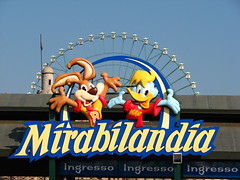
The evolution of the modern roller coaster has mirrored the development of the logically positivist guided modernity in general, and as such I believe is subject to a similar critique as the French Romanticist or Marxian Historical Materialist perspectives provided society at large. Originally functioning as a tool for social purposes, the roller coaster began to develop its own purely aesthetic language unique from other social amusements, which can explain the otherwise redundant re-interpretations of the coaster experience within the same parkgrounds as designers began to experiment with new variations of layout to different effects. Because these endeavors are reliant on capitalism to come to fruition, it was not long before business leaders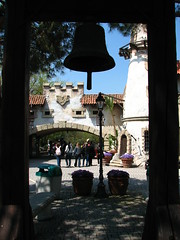 began attempting to find ways to streamline production in order to capitalize on maximizing returns. These competing interests were able to co-evolve as was true for many other modern artforms (especially the cinema), but the roller coaster’s larger reliance on production and technology meant the very notion that aesthetics was necessary to creation almost completely dissolved. Thus the few remaining emotive values the coaster provided became abstracted from their original context, engineers trying to exert their control over a medium that relied on organic unpredictability by developing computer-designed, laser-cut, force-vector engineering so that sensation or appearance could be quantifiably maximized and they could ensure the greatest competitive advantage. These advances in technology brought with them new maladies unheard of in previous eras, such as the need for tighter gripping wheel assemblies and more secure restraints, which exacerbated problems caused by roughness or imperfection, requiring even more sterilized and conservative track configurations as a solution. Rides were getting bigger, faster, and more innovative, but not better. Even the original purpose of coaster as social function has been marginalized through new vehicles
began attempting to find ways to streamline production in order to capitalize on maximizing returns. These competing interests were able to co-evolve as was true for many other modern artforms (especially the cinema), but the roller coaster’s larger reliance on production and technology meant the very notion that aesthetics was necessary to creation almost completely dissolved. Thus the few remaining emotive values the coaster provided became abstracted from their original context, engineers trying to exert their control over a medium that relied on organic unpredictability by developing computer-designed, laser-cut, force-vector engineering so that sensation or appearance could be quantifiably maximized and they could ensure the greatest competitive advantage. These advances in technology brought with them new maladies unheard of in previous eras, such as the need for tighter gripping wheel assemblies and more secure restraints, which exacerbated problems caused by roughness or imperfection, requiring even more sterilized and conservative track configurations as a solution. Rides were getting bigger, faster, and more innovative, but not better. Even the original purpose of coaster as social function has been marginalized through new vehicles which separate riders into their own compartmentalized riding environment, emphasizing one’s relationship with the experience as that between self-and-object rather than self-and-society. It therefore should come as no surprise that one of the latest of these modern coasters is arbitrarily named just to capitalize on the mimetic plague started by a Californian company who coined the ubiquitous single vowel prefix to their brand emphasizing consumer’s isolated ownership of their gizmo and how this piece of technology should existentially define themselves as a human being.
which separate riders into their own compartmentalized riding environment, emphasizing one’s relationship with the experience as that between self-and-object rather than self-and-society. It therefore should come as no surprise that one of the latest of these modern coasters is arbitrarily named just to capitalize on the mimetic plague started by a Californian company who coined the ubiquitous single vowel prefix to their brand emphasizing consumer’s isolated ownership of their gizmo and how this piece of technology should existentially define themselves as a human being.
Typical of romanticism or Marxism there’s some idealist naivety to the critical history described above, but also I think some things valuable to consider between the lines. This isn’t to say there’s no room for genuine artistic vision in the modern world of amusement and theme parks (note this is a distinctly different term from “Imagineers” who mostly act as set designers). John Wardley is such a figure who manages decent work from within the system. The tragically late Will Koch is another, and luckily his enthusiast-perspective is still influenced in his collaborators at the Gravity Group along with the artisanship of competing Great Coasters. While I’ve seen little empirical evidence that coaster guru Werner Stengel recons himself as much an aesthete as an engineer, the results occasionally suggest he is keeping quiet with some secrets; notably evidenced in the sequentially and rhythmically perfect Maverick, which was perhaps the first time modern technology was used in a way not just to match, but to exceed what traditional design methods were artistically capable of. With an emphasis on innovation of layout ahead of innovation of technology, and using force-design methods not to water down and control the experience but rather push the boundaries of precision pacing and timing to their extreme limits (while introducing rotation and torque as new and fundamentally essential color palates to the existing tri-color tones of positive, negative and lateral forces designers were once confined to) it seems as though the modern steel roller coaster may have finally come of age. Therefore it was with excited idealism rather than the usual postmodern ennui that I approached (with surprising vitality despite the sleeping accommodations the prior night) the second and still only other completed example of an Intamin LSM Blitz roller coaster, iSpeed.
Group along with the artisanship of competing Great Coasters. While I’ve seen little empirical evidence that coaster guru Werner Stengel recons himself as much an aesthete as an engineer, the results occasionally suggest he is keeping quiet with some secrets; notably evidenced in the sequentially and rhythmically perfect Maverick, which was perhaps the first time modern technology was used in a way not just to match, but to exceed what traditional design methods were artistically capable of. With an emphasis on innovation of layout ahead of innovation of technology, and using force-design methods not to water down and control the experience but rather push the boundaries of precision pacing and timing to their extreme limits (while introducing rotation and torque as new and fundamentally essential color palates to the existing tri-color tones of positive, negative and lateral forces designers were once confined to) it seems as though the modern steel roller coaster may have finally come of age. Therefore it was with excited idealism rather than the usual postmodern ennui that I approached (with surprising vitality despite the sleeping accommodations the prior night) the second and still only other completed example of an Intamin LSM Blitz roller coaster, iSpeed.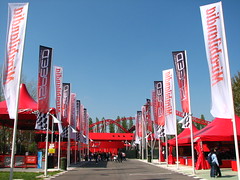
The coaster obviously takes greater influence from Intamin’s Xcelerator or Storm Runner brand of hydraulic launch coasters, with the use of LSMs and three-car trains serving as the primary technical kinship to Maverick’s company. Still, one look at the ground level twists, turns, rollovers and hops does indicate a spirit for favoring layout above individual elements that is very much in line with Maverick, despite iSpeed’s preference for consistent roller coaster lyricism set at one steady tempo (crazy) rather than the originator’s emphasis on a narrative progression of elements.
Perhaps it will be better to attempt to define iSpeed not in terms of what it isn’t but of what it is. The magnetic launch to nearly 75mph lacks some of the initial ‘pop’ of the cable-towed variety but it maintains a surprisingly fast rate of acceleration down a seemingly short runway before shooting up into the opening tophat, which are necessary not just for the thrills offered by this stunning vertical element which provides the definitive opening act sequence, but because they need the first hill to be tall enough so a launch at any speed will result in either a rollback or a complete circuit, no risks of midcourse valleying. Though some good airtime is necessarily required around the crests out-of and into vertical (the moment when we first start to pull over the top but are still tipped mostly on our backs always freaks me out, not just because I suddenly worry if my cell-phone is secure in my pocket), it’s the slight pause on top that I love the most. While sitting
to nearly 75mph lacks some of the initial ‘pop’ of the cable-towed variety but it maintains a surprisingly fast rate of acceleration down a seemingly short runway before shooting up into the opening tophat, which are necessary not just for the thrills offered by this stunning vertical element which provides the definitive opening act sequence, but because they need the first hill to be tall enough so a launch at any speed will result in either a rollback or a complete circuit, no risks of midcourse valleying. Though some good airtime is necessarily required around the crests out-of and into vertical (the moment when we first start to pull over the top but are still tipped mostly on our backs always freaks me out, not just because I suddenly worry if my cell-phone is secure in my pocket), it’s the slight pause on top that I love the most. While sitting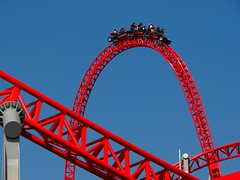 on a launch strip contemplating the idea of a coaster this intense might seem still too distant and abstract a concept, after the opening act bang of launch and vertical twist, the moment of silence peering above the world on an unsupported arch of red track lets the full reality of my situation sink in, allowing a heightened appreciation of the chaos to follow.
on a launch strip contemplating the idea of a coaster this intense might seem still too distant and abstract a concept, after the opening act bang of launch and vertical twist, the moment of silence peering above the world on an unsupported arch of red track lets the full reality of my situation sink in, allowing a heightened appreciation of the chaos to follow.
Falling back down to ground level several meters farther than we ascended, there’s a quick right to left S-bend in the track which wasn’t as pronounced and noticeable riding in person as I had hoped from watching the POV videos. This is breathlessly followed by a long rounded camelback hill, whose viciously fast pace actually distracts one’s attention away from the abundant ejector airtime, which might also be slightly compromised by a short strip of magnetic trim brakes over the top, throwing one slightly forward into their restraints in addition to straight up.
The loss of speed is hardly discernable as the train pulls up before ground level and suddenly careens around its heartline to the left and a split second later an even wider rotational transition sends us hurling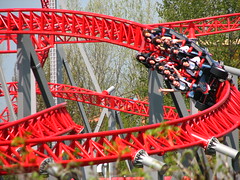 back to the right. This transition certainly aims to hit big and hard as a unique element in its own right, with an extreme banking change and lightning pace. That said, maybe it’s the need of an airtime pop hidden in the heartline, but the rotation didn’t seem quite as dynamic as it could have been, the train seeming to ‘sweep’ from left to right rather than a more violent ‘twist’. It sets the right tone for the high-speed curve that follows, also sweeping low to the ground, crafting some decent positives while the sense of sustained speed is incredible. If not the most extreme element in the coaster, its serves the layout perfectly as it’s a midcourse ‘pause’ that emphasizes its central theme of velocity before reigniting the nonstop pace of back-and-forth twisting.
back to the right. This transition certainly aims to hit big and hard as a unique element in its own right, with an extreme banking change and lightning pace. That said, maybe it’s the need of an airtime pop hidden in the heartline, but the rotation didn’t seem quite as dynamic as it could have been, the train seeming to ‘sweep’ from left to right rather than a more violent ‘twist’. It sets the right tone for the high-speed curve that follows, also sweeping low to the ground, crafting some decent positives while the sense of sustained speed is incredible. If not the most extreme element in the coaster, its serves the layout perfectly as it’s a midcourse ‘pause’ that emphasizes its central theme of velocity before reigniting the nonstop pace of back-and-forth twisting.
 As far as I’m concerned this next short sequence of track is the best in all of continental Europe, and possibly up there for one of the most inspired in the world. It’s a deceptively simple stretch of track: a right to left curving camelback hill feeds directly into a left to right barrel roll over the station. In words and off-ride pictures it’s nothing that strikes one to be of immediate importance but when experienced firsthand it’s absolutely mind blowing. The first hill flows naturally and inconspicuously out of the preceding turnaround, echoing a more subdued version of the first sweeping switchback. The banking pitch of the track begins a steady rotation out of the banked left turn, this movement continuing uninterrupted as we crest the hill with a dash of floater air and continue rotating to our left. Rather than slow the pace down once our
As far as I’m concerned this next short sequence of track is the best in all of continental Europe, and possibly up there for one of the most inspired in the world. It’s a deceptively simple stretch of track: a right to left curving camelback hill feeds directly into a left to right barrel roll over the station. In words and off-ride pictures it’s nothing that strikes one to be of immediate importance but when experienced firsthand it’s absolutely mind blowing. The first hill flows naturally and inconspicuously out of the preceding turnaround, echoing a more subdued version of the first sweeping switchback. The banking pitch of the track begins a steady rotation out of the banked left turn, this movement continuing uninterrupted as we crest the hill with a dash of floater air and continue rotating to our left. Rather than slow the pace down once our rears regain contact with our seats, the pullout on the other side is much quicker and more aggressive, the rotation still in the same direction but increasing in pace to an alarming rate. Laid out ahead of us is an arched barrel roll, an inverted image the first half of the sequence and a surreally apocalyptic view from the front row to boot. In a split second, we once again achieve a pop of floater while the train warps around and completely upside down, the bright red station roof below (that is, above) dancing around our extended fingertips. At this point I always had to call into question if what I was experiencing was real and not some computer simulated representation. I cannot praise this maneuver enough; it’s exactly the sort of track I’m calling for when I ask for better, more intelligent pacing and sequencing from modern designers.
rears regain contact with our seats, the pullout on the other side is much quicker and more aggressive, the rotation still in the same direction but increasing in pace to an alarming rate. Laid out ahead of us is an arched barrel roll, an inverted image the first half of the sequence and a surreally apocalyptic view from the front row to boot. In a split second, we once again achieve a pop of floater while the train warps around and completely upside down, the bright red station roof below (that is, above) dancing around our extended fingertips. At this point I always had to call into question if what I was experiencing was real and not some computer simulated representation. I cannot praise this maneuver enough; it’s exactly the sort of track I’m calling for when I ask for better, more intelligent pacing and sequencing from modern designers.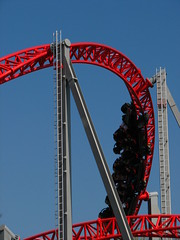
As phenomenal as this sequence is, it also serves as iSpeed’s ultimate downfall, simply because once it climaxes with this first rollover, it’s impossible to do anything to top it. A final quick bank to the right leads into a straight stretch of dead track, which I think once had a few trims on it but these have since been removed. Not a sin by itself, it could easily be a break of pace to set up the final elements, but if that is what this promises, the next ten seconds of ride time do not deliver at all. First it curves up into a pseudo-Immelmann type inversion, although it’s so spread out and tilted to one side it feels more like an overbanked turn which I am rarely a fan of. The frenetic pace is killed by this element, but there’s still enough orientation changes to keep it interesting if you know where to look. Upon exiting this loop there’s a long 270° sweeping turnaround that’s disappointingly ‘meh’, especially in contrast to the high-octane ride experienced not long ago. If the loop could have been tighter and more vertically oriented it also would have solved the problem of the turn after it, as it too would need to have more whip to get around to the final element, the second heartline roll. 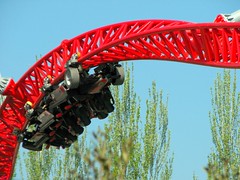
This is an odd element because it seems to be based on geometric principles (rotate around the heartline axis at a constant rate while in a straight line) rather than the force-based design principles seen everywhere else. This results in some rather peculiar forces and dynamics to be generated just because of our changing orientation to gravity with no other forces to counteract these, plus the added affects of the rotation itself. I think the original idea many years ago was that the inline rotation would somehow ‘cancel out’ the gravitational pull on the rider in much the same way a spinning bicycle wheel as gyroscope can balance vertically when attached to a string on one side, but the rotation clearly isn’t fast enough to achieve anywhere near that effect. “Oh well”,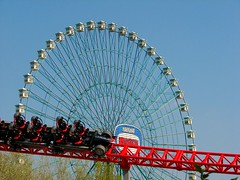 Stengel must have figured, “it still comes well within the necessary g-force envelopes and it’s popular with riders,” and so they continued to grandfather this antiquated 90’s maneuver into modern designs due to the proven successful record in (almost) all attempts.
Stengel must have figured, “it still comes well within the necessary g-force envelopes and it’s popular with riders,” and so they continued to grandfather this antiquated 90’s maneuver into modern designs due to the proven successful record in (almost) all attempts.
I’d say that iSpeed is better off for this; it’s a quirky fun element to end the main sequence of the ride proper with. Pacing is a bit wonky but after the last couple maneuvers it was DOA anyway, so to suddenly try to get the split-second timing and variation in dynamics back would have been out of place anyway. It’s not quite as cool as Blue Fire’s final heartline twist (the restraining devices being the biggest difference between the two) but is one of the better ‘individual moments’ in the entire ride.
The train then curves up to the right into what appears to be one of the first attempts at a pseudo-midcourse brake run since they started using magnets for deceleration. (Or is it just an early final brake that doesn’t fully trigger? Or is it the same difference?) Here’s a lesson Stengel and/or Intamin seem to have yet learned: when the car is rotating around the heartline, you can’t have that rate of rotation suddenly drop to zero the moment it reaches the level pitch you want. The bodies on board will continue to carry that rotation for a moment and as a result may clink their jawbones against the restraints unless they prepare for it. Same goes for the entry into the heartline rotation at the other end of this block brake. Watch an onride reverse video and you’ll notice this is where the riders get jerked around the most. Only with Intamin could you find that a flat stretch of brake track to be the roughest part of an otherwise butter-smooth ride.
part of an otherwise butter-smooth ride.
After this long brake run is the post-ride epilog, consisting of a twisting slope down to a small, mostly airless bunny hop, then a final quick left turn into a very short brake run which brings the train to a halt inside the station building. There are two ways of looking at this track: a fun post-ride section that extends what otherwise would have been a finished experience, or a waste of a fixed amount of resources that could have been used to greater effect with more strategic designing. There’s also a third way to analyze it which is concurrently true to either of the first choices above: Werner envisioned it from start to finish like a game of RollerCoaster Tycoon, and when he got near the end he realized he built himself in from connecting it to the station with a full-length brake run as he normally would, so he had to improvise a solution. Since I want to like iSpeed as much as I can, I’ll look at this as a good thing because I want to experience odd design patterns I couldn’t find at another park closer to home, even if they’re ultimately pointless.
like a game of RollerCoaster Tycoon, and when he got near the end he realized he built himself in from connecting it to the station with a full-length brake run as he normally would, so he had to improvise a solution. Since I want to like iSpeed as much as I can, I’ll look at this as a good thing because I want to experience odd design patterns I couldn’t find at another park closer to home, even if they’re ultimately pointless.
I wouldn’t quite call iSpeed a top ten ride. It gets really, really close, but then inexplicably suffers from a bout of stage fright and can’t get through the last act without someone feeding it lines, and there’s a delayed set change-over when it discovers it doesn’t know how to get to the conclusion. Even if it had been able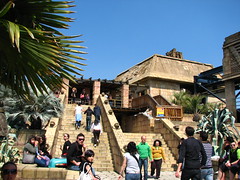 to take the great momentum from the first 2/3 of the layout and carry it all the way to the brakes, I’m generally one to favor multi-phase progression over singular consistency, even if it is consistently awesome.
to take the great momentum from the first 2/3 of the layout and carry it all the way to the brakes, I’m generally one to favor multi-phase progression over singular consistency, even if it is consistently awesome.
Speaking of coasters that are consistently awesome, Katun, Mirabilandia’s monolithic B&M inverted coaster, is also frequently described as such among enthusiast circles, where its reputation even extends to being one of B&M’s penultimate creations and a top ten contender for worldwide steel coasters. This legacy begins when one simply gazes upon this thing, the dark navy structure towering over the entire landscape as the second tallest and largest full-circuit inverted coaster protruding from the earth’s crust, second only to the nearly hypercoaster-sized Alpengeist.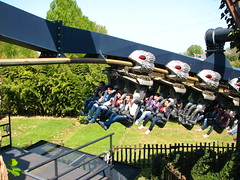 It continues into the station, an incredibly detailed Mayan temple which tells one that, unlike Six Flags or Cedar Fair, this park doesn’t have to ‘trade-off’ themeing with ride scale in their capital budget; no expense was spared for Katun. The layout owes inspiration from the much-loved Raptor, exceeding that one in scale in nearly every regard.
It continues into the station, an incredibly detailed Mayan temple which tells one that, unlike Six Flags or Cedar Fair, this park doesn’t have to ‘trade-off’ themeing with ride scale in their capital budget; no expense was spared for Katun. The layout owes inspiration from the much-loved Raptor, exceeding that one in scale in nearly every regard.
Furthermore, it’s one of those coasters which enthusiasts get to describe using their special F-word… no, not that special F-word, the other one. Forceful. Both vertical loop and cobra roll in particular both lay down the positive g’s and keep them there all the way around their titan radii, and the world’s largest zero-g camelback hill with a devilish ground-level high-speed turn are the only things separating these two dynamos apart. Salivating yet?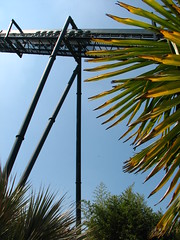 Good, you’re not alone. Unfortunately, (and this seems to be a recurring theme in my life) I was alone when I disembarked from my first front-row experience on Katun, figuratively in addition to the standard literally.
Good, you’re not alone. Unfortunately, (and this seems to be a recurring theme in my life) I was alone when I disembarked from my first front-row experience on Katun, figuratively in addition to the standard literally.
“Well, what did we think of that? Any good?”
“I don’t know. Honestly, I’m kind of ambivalent towards it.”
“Yeah… I might have to agree with that. Crap, I really hoped for otherwise.”
“This is supposed to be one of the best in the world. We’re going to be in serious shit when we publish the review, aren’t we?”
“Quite possibly, we shall have to wait and see.” (Yes, I do often keep an internal narrative with myself using the majestic plural.)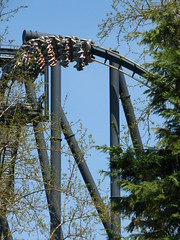
I will not hide the fact that I am prejudiced against B&M coasters to the degree most contrary to popular enthusiast opinions. It is a prejudice that is rooted in deeply held aesthetic beliefs and personal experience, exemplifying the critic of coaster modernity outlined in the opening paragraphs… but a prejudice nonetheless. It is not without exception, as both Nemesis and Raptor are firmly planted in my top ten list while numerous others round out lower rankings, and I boarded Katun with a genuinely open mind and a reasonable hope that it might manage to eclipse Cedar Point’s baby, but when I finished I couldn’t ignore the fact that it too fell victim to the hallmark of every other cherished B&M coaster I’ve wrote off as merely passable. I suppose it unlikely that I will manage to sway many of the few voters that put Katun in the top ten of the Internet Coaster Poll, but perhaps I can at least fully describe my perspective so an intelligent dialogue can be held afterward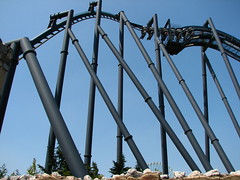 (and hopefully with other people, for a change!)
(and hopefully with other people, for a change!)
“Forcelessness” is often a cop-out argument against B&M, not particularly valid unless a lot of clauses are added to differentiate it from installations that I do think are successful for their reserved gracefulness (besides, “forceless” technically implies zero-g’s, which I think might be considered a very good thing among many). Plus, as I already noted in my opening teaser, it wouldn’t be a very sound argument either, as Katun features many moments which can be described as “forceful”. Nevertheless I will use a derivative of that argument for Katun, which is the accusation that it is mostly “dynamic-less”. Force is there, but changes in force or other ride experience factors happen slowly or at mostly arbitrary times. This problem develops not simply in spite of the high speeds and huge scale unique to Katun, but because of it. As Millennium Force proudly demonstrates, bigger hills and faster turns physically necessitate slower timing and more conservative dynamics (save for rotational) if they are to remain within acceptable safety limits; notice how the smallest children’s coasters can also sometimes be the most violent.
arbitrary times. This problem develops not simply in spite of the high speeds and huge scale unique to Katun, but because of it. As Millennium Force proudly demonstrates, bigger hills and faster turns physically necessitate slower timing and more conservative dynamics (save for rotational) if they are to remain within acceptable safety limits; notice how the smallest children’s coasters can also sometimes be the most violent.
The first drop is long, with maybe a bit of float in the back rows, but otherwise not much more interesting beside the initial height and eventual accumulation of speed, which is about as good as far as first drops go. The vertical loop holds positive G-forces all the way around, the taller, narrower construction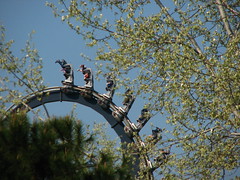 with wide radius bases keeping them consistently strong around the entire circumference. The zero-G roll, as implied, is mostly forceless, but it’s also the only place that rotational dynamics really come into play during the ride. Then there’s the ground-level turn, which is good for watching one’s feet whizz above, and then the cobra roll,
with wide radius bases keeping them consistently strong around the entire circumference. The zero-G roll, as implied, is mostly forceless, but it’s also the only place that rotational dynamics really come into play during the ride. Then there’s the ground-level turn, which is good for watching one’s feet whizz above, and then the cobra roll,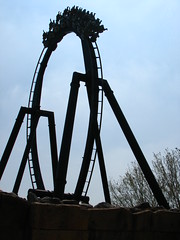 which again holds the force with a small snap at each apex. This is the coaster’s signature sequence which is supposed to make it so venerable, but amid all the forces I could hardly be made to actually feel anything. By comparison, I didn’t start to notice anything of interest on the taller, faster and more g-force laden Alpengeist until I got tunnel vision on the exit of the cobra roll, when I finally realized it probably was being intense. It’s possible Katun was running a bit slow that day, but I didn’t experience anything like that on any of my rides, and apart from the zero-g roll and turn I don’t see what else Katun is attempting to do differently with this sequence that would make it superior to Alpengeist’s opener. Instead the forces, until they start physiologically affecting my perceptions, just blend into the equivalent of white noise in music. I can’t see the appeal.
which again holds the force with a small snap at each apex. This is the coaster’s signature sequence which is supposed to make it so venerable, but amid all the forces I could hardly be made to actually feel anything. By comparison, I didn’t start to notice anything of interest on the taller, faster and more g-force laden Alpengeist until I got tunnel vision on the exit of the cobra roll, when I finally realized it probably was being intense. It’s possible Katun was running a bit slow that day, but I didn’t experience anything like that on any of my rides, and apart from the zero-g roll and turn I don’t see what else Katun is attempting to do differently with this sequence that would make it superior to Alpengeist’s opener. Instead the forces, until they start physiologically affecting my perceptions, just blend into the equivalent of white noise in music. I can’t see the appeal.
 Dynamicism is by no stretch of the imagination necessary to a good coaster, but I do find that when in doubt, it never hurts. The second way to approach Katun’s opening act as a masterpiece of steel genius I think is to praise it for its awe-inspiring elegance… that is, a rejection of high dynamics in order to make a great coaster. For my tastes, Wildfire has succeeded on this argument, Griffon has succeeded on this argument, and (jumping manufacturers) so was my ultimate argument in favor of Millennium Force that some people failed to recognize as being positive. Certainly Katun should as well? Well, it might have had that potential, but I don’t think it should have been born as an inverted coaster if that’s the sort of ride they were attempting. For this effect to work, you need to have full exposure and awareness of your surroundings
Dynamicism is by no stretch of the imagination necessary to a good coaster, but I do find that when in doubt, it never hurts. The second way to approach Katun’s opening act as a masterpiece of steel genius I think is to praise it for its awe-inspiring elegance… that is, a rejection of high dynamics in order to make a great coaster. For my tastes, Wildfire has succeeded on this argument, Griffon has succeeded on this argument, and (jumping manufacturers) so was my ultimate argument in favor of Millennium Force that some people failed to recognize as being positive. Certainly Katun should as well? Well, it might have had that potential, but I don’t think it should have been born as an inverted coaster if that’s the sort of ride they were attempting. For this effect to work, you need to have full exposure and awareness of your surroundings  (preferably while a hundred feet off the ground), but the inverted car design boxes in one’s field of view, the head is closer to the track and the suspended seats ahead of you fills in the forward view all the way down to your kneecaps; imagine the hilarity that would ensue if someone were to advertise “stadium seating” on an inverted coaster to promote improved onride visuals. Even in the front row you can’t see the sky unless you’re upside down (which I recall in an interview was the impetus for Claude and Walter’s development of the floorless coaster), so the best way to get a sense of your surroundings is by looking down between your feet. In the history
(preferably while a hundred feet off the ground), but the inverted car design boxes in one’s field of view, the head is closer to the track and the suspended seats ahead of you fills in the forward view all the way down to your kneecaps; imagine the hilarity that would ensue if someone were to advertise “stadium seating” on an inverted coaster to promote improved onride visuals. Even in the front row you can’t see the sky unless you’re upside down (which I recall in an interview was the impetus for Claude and Walter’s development of the floorless coaster), so the best way to get a sense of your surroundings is by looking down between your feet. In the history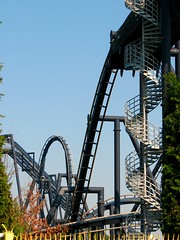 of humans gazing in wonder at the massive scale of objects that dwarf their own significance, it’s not psychologically intuitive that this can be achieved while looking down towards one’s navel. (Don’t take this as a slam in general to inverted coasters, as I noted my two favorite B&M coasters are Raptor and Nemesis and I wouldn’t want either of those as traditional sitdown coasters. I just think it’s wise to recognize the strengths and weaknesses of each configuration.)
of humans gazing in wonder at the massive scale of objects that dwarf their own significance, it’s not psychologically intuitive that this can be achieved while looking down towards one’s navel. (Don’t take this as a slam in general to inverted coasters, as I noted my two favorite B&M coasters are Raptor and Nemesis and I wouldn’t want either of those as traditional sitdown coasters. I just think it’s wise to recognize the strengths and weaknesses of each configuration.)
Sequencing and progression are another problem with Katun, there’s really not much urgency to any one element, and remove one section of the layout and you’ll find you’ve got the exact same ride experience, minus that one section. As I’ve commented on other B&M coasters, it’s designed in such a way that even after multiple re-rides, the experience signifies little more than one damn thing happening after another. A zero-G roll adds rotation between two long, sustained positive G sections of track. Any significance why that’s there, in context of the other elements and overall experience,  beside just to have it? No significance that I could give it. Even still, the first sequence of maneuvers until the cobra roll would be alright, but then the ride quality drops off precipitously afterward, falling victim of the near-universal B&M curse that the second half is always underwhelming compared to the first. The midcourse safety brake feels to the rider not much more than a missed opportunity for another good element and is poorly integrated in the sequence, and then the finale consists of two basic corkscrews which are inferior in every way to each inversion that came in the first half, separated by a straight section of track in a tunnel, and a helix which attempts to mimic the success found on Raptor’s powerful finale but is so unconvincingly lifeless, I don’t care what your impression of Katun until this point was, you gotta admit by the very end they were just phoning it in.
beside just to have it? No significance that I could give it. Even still, the first sequence of maneuvers until the cobra roll would be alright, but then the ride quality drops off precipitously afterward, falling victim of the near-universal B&M curse that the second half is always underwhelming compared to the first. The midcourse safety brake feels to the rider not much more than a missed opportunity for another good element and is poorly integrated in the sequence, and then the finale consists of two basic corkscrews which are inferior in every way to each inversion that came in the first half, separated by a straight section of track in a tunnel, and a helix which attempts to mimic the success found on Raptor’s powerful finale but is so unconvincingly lifeless, I don’t care what your impression of Katun until this point was, you gotta admit by the very end they were just phoning it in.
Ultimately I found Katun an inoffensive roller coaster, and even at times a fairly fun one. However, it fundamentally missed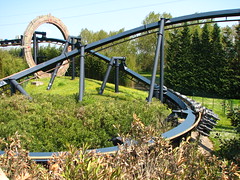 making any significant emotional connection with me, whether my first ride or last. Upon rerides any favorable interest I had was still as detached and rational as the effort in creating it obviously was, and there were many times especially in the second half where I would be actively criticizing the coaster as I was riding. Even with the negative points I made about iSpeed’s last act, I at least was involved in the moment enough that it wasn’t until after the ride was over that I started analyzing whether anything could have been changed to make the experience even better. That everyone else comes back with nothing but raves slightly baffles me, but then again there are a lot of things about popular culture that confuse me to no end.
making any significant emotional connection with me, whether my first ride or last. Upon rerides any favorable interest I had was still as detached and rational as the effort in creating it obviously was, and there were many times especially in the second half where I would be actively criticizing the coaster as I was riding. Even with the negative points I made about iSpeed’s last act, I at least was involved in the moment enough that it wasn’t until after the ride was over that I started analyzing whether anything could have been changed to make the experience even better. That everyone else comes back with nothing but raves slightly baffles me, but then again there are a lot of things about popular culture that confuse me to no end.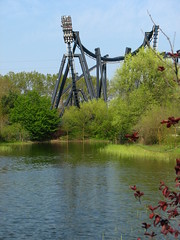
As an unrelated comment, why is it that the northern Italian parks (this one and Gardaland) seem so adverse to naming their major attractions in their own language? Admittedly ‘Katun’ comes from the ancient Mayans (or so the RCDb claims) but the absence of a vowel at the end makes it awkward to say in the Italian language, and the same is seen in almost every other ride: iSpeed, Reset, Explorer, Family Adventure, Blue Tornado, Magic Mountain, Sequoia Adventure, Space Vertigo… all without Italian subtitles underneath. That these bland, hard English words are substituting a language which is recognized for being one of the most lyrically beautiful to speak seems sad, and confusing in light of English being far from universally spoken among Italians. I do wonder: English speakers often name something in a foreign language if they want it to sound exotic or exciting, and while the reverse might be true for Italians, I somehow think that’s not the full story. Perhaps a reader for whom English is not their primary language can answer, is there any sort of connotation attached to using English words that transforms their meaning than if they were to be used in the native tongue?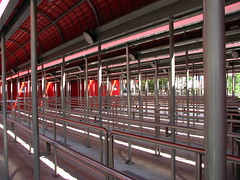
For some notes on operations and attendance, after checking my bag that morning cheaply and efficiently, I made a beeline to iSpeed to become one of its first riders. They had two trains on the track but for the time being were cycling one empty while only loading the other. This didn’t really matter because for the first hour I was able to get nearly unlimited rerides without having to wait even a single cycle. When the queue did start to build up, I thought it best to move on to other interests and return later, and when I did I found they were still letting one train launch empty despite the accumulation of what had to have been at least a half hour queue waiting for a single 12 seat train. Extremely odd for more than one reason; even if capacity was such a non-concern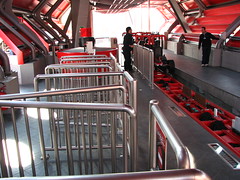 they couldn’t be bothered to stop intentionally letting seats go empty, I’m curious how much their utility company charges every time the operator presses the dispatch button. But as spent the majority of my time with iSpeed at the beginning and end of the day when queues were walk-on despite the single train, in total I think I got somewhere in the neighborhood of 15 to 20 rides.
they couldn’t be bothered to stop intentionally letting seats go empty, I’m curious how much their utility company charges every time the operator presses the dispatch button. But as spent the majority of my time with iSpeed at the beginning and end of the day when queues were walk-on despite the single train, in total I think I got somewhere in the neighborhood of 15 to 20 rides.
The same operational malaise was encountered on Katun, but likewise this didn’t end up being a problem. One train cycled the tracks all day, which made instances of line-jumping (in the form of two girls inviting two of their friends to join them for a front row ride that would have gone to me and another single rider) all the more frustrating. After morning ‘crowds’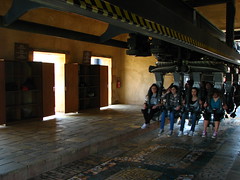 had started to disappear, they would hold that train in the station for at least five minutes before starting another restraint lock and check. This just meant that I had enough time to make it down the exit ramp, back up the queue and into another seat for an immediate re-ride, so small were the crowds. This even allowed for a front row ride or two provided a group of two or three were waiting. For Katun I experienced close to 15 dispatches before the visit was over, perhaps as the best alternative to iSpeed to spend my time, as well as a chance to make absolutely positive I knew what my feelings toward the coaster were. Along with my iSpeed marathons while still fitting in more than enough time to give the rest of the park the once-over, despite the missed day of classes, going on an early season weekday was definitely the way to go.
had started to disappear, they would hold that train in the station for at least five minutes before starting another restraint lock and check. This just meant that I had enough time to make it down the exit ramp, back up the queue and into another seat for an immediate re-ride, so small were the crowds. This even allowed for a front row ride or two provided a group of two or three were waiting. For Katun I experienced close to 15 dispatches before the visit was over, perhaps as the best alternative to iSpeed to spend my time, as well as a chance to make absolutely positive I knew what my feelings toward the coaster were. Along with my iSpeed marathons while still fitting in more than enough time to give the rest of the park the once-over, despite the missed day of classes, going on an early season weekday was definitely the way to go.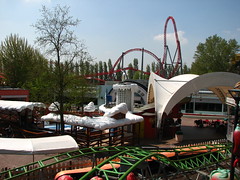
I’d be hard pressed to name you a park with quite as exaggerated a dichotomy in their ride portfolio than Mirabilandia. Holiday World and a post-Big Bad Wolf Busch Gardens Europe come to mind, but even at these locations their collection of big guns doesn’t seem totally out of place (Holiday World finds its nucleus almost entirely through wet attractions, however). How does a novice Italian thrill seeker make the jump from Pakal to Katun while at Mirabilandia? When I’d describe the park to others I’d say their biggest draws are a log flume, dark ride, a wild mouse and an S&S combo tower, the last of which is admittedly a bit more thrilling but also a dime a dozen and never do much for me. Oh, but they also have two coasters that would be top-tier standouts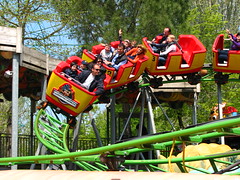 if located on the Cedar Point peninsula. Does this make Mirabilandia a large regional theme park that for some reason has neglected their middle lineup? Or are they a small local park that somehow has had the courage to twice pony up the big bucks for an attraction of worldwide renown?
if located on the Cedar Point peninsula. Does this make Mirabilandia a large regional theme park that for some reason has neglected their middle lineup? Or are they a small local park that somehow has had the courage to twice pony up the big bucks for an attraction of worldwide renown?
Given the obvious expense involved in themeing and landscaping many of the midways the first choice seems a more likely description. Mirabilandia was open for customers only as distantly as 1992, and the growing park in the time since seems characteristic of how many corporate amusement centers have handled capital expansions: invest only in that which would make them a market leader for a key target demographic, i.e. adults/teens, or families (defined only by their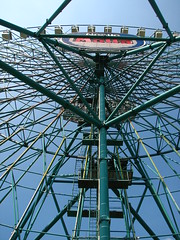 youngest children). Before the massive competition that started in the late 80’s to early 90’s, parks didn’t feel the marketing pressure to have a highly specific push to one of these target markets and you got individual attractions that were less deal-makers in getting people into the park than day-makers meant to further the enjoyment once inside. Despite many unfavorable reports, I’m saddened that Mirabliandia chose to demolish Sierra Tonante, Italy’s only wooden coaster, to make way for iSpeed, not just because of its unique value for the region but just because a coaster bigger than a wild mouse but without multiple heartline loops, 70mph speeds and a restrictive height limit
youngest children). Before the massive competition that started in the late 80’s to early 90’s, parks didn’t feel the marketing pressure to have a highly specific push to one of these target markets and you got individual attractions that were less deal-makers in getting people into the park than day-makers meant to further the enjoyment once inside. Despite many unfavorable reports, I’m saddened that Mirabliandia chose to demolish Sierra Tonante, Italy’s only wooden coaster, to make way for iSpeed, not just because of its unique value for the region but just because a coaster bigger than a wild mouse but without multiple heartline loops, 70mph speeds and a restrictive height limit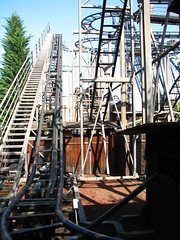 is exactly the sort of middle-ground attraction this place could use more of. As in many other modern parks the best bridging attractions between these two extremes are ones marketed as wet rides, also for a specific target audience with some crossovers but still frequently to the exclusion of others.
is exactly the sort of middle-ground attraction this place could use more of. As in many other modern parks the best bridging attractions between these two extremes are ones marketed as wet rides, also for a specific target audience with some crossovers but still frequently to the exclusion of others.
2008’s Reset dark ride has the most cross-demographic appeal, but I’ll get to that one later. The first of the ‘other’ rides I rode was the next biggest coaster in their collection, Pakal. This L&T Systems Wild Mouse is given a South American gold mining theme to help it fit in with the setting around Katun. Although this was my first time sampling one by this manufacturer, the ride was a typical wild mouse experience, with a few more sharp hairpin turns in the second half, and taller, narrower vehicles which made it look more precarious from off-ride.
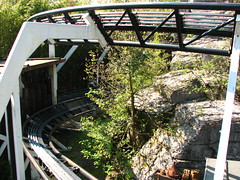 Nearby was Explorer, the first of three children’s coasters, and the park’s only powered. It’s a basic Blauer Enzian configuration, with the loading station track tipped to the left by several degrees. They had the good sense to place dense plants, rocks and other jungle artifacts along the layout so it wasn’t just a figure-eight in a field, but it was still underwhelming compared to some of Europe’s better Mack powered coasters. The S&S towers
Nearby was Explorer, the first of three children’s coasters, and the park’s only powered. It’s a basic Blauer Enzian configuration, with the loading station track tipped to the left by several degrees. They had the good sense to place dense plants, rocks and other jungle artifacts along the layout so it wasn’t just a figure-eight in a field, but it was still underwhelming compared to some of Europe’s better Mack powered coasters. The S&S towers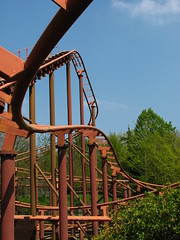 I decided weren’t worth my time to even check if there was a wait built up, but I did hop on the other two gravity powered kiddie coasters as I walked by, partly to add more titles to my record, partly because they honestly were some of the more appealing rides in the park. Leprotto Express was another L&T Systems children’s ride, and the ‘smallness’ of it can actually be a good thing, as the tight turns and sudden hills can be as surprisingly aggressive as the majority of Katun (less force but more diversity). Family Adventure rounded out the park’s impressive kiddie coaster collection, and despite the name this Vekoma Roller Skater (the same model as Cedar Point’s Woodstock Express) is the most mature of the bunch,
I decided weren’t worth my time to even check if there was a wait built up, but I did hop on the other two gravity powered kiddie coasters as I walked by, partly to add more titles to my record, partly because they honestly were some of the more appealing rides in the park. Leprotto Express was another L&T Systems children’s ride, and the ‘smallness’ of it can actually be a good thing, as the tight turns and sudden hills can be as surprisingly aggressive as the majority of Katun (less force but more diversity). Family Adventure rounded out the park’s impressive kiddie coaster collection, and despite the name this Vekoma Roller Skater (the same model as Cedar Point’s Woodstock Express) is the most mature of the bunch,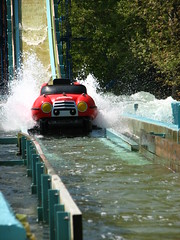 and apparently popular enough to warrant a transfer track with a second train; this is something not even Cedar Point’s has!
and apparently popular enough to warrant a transfer track with a second train; this is something not even Cedar Point’s has!
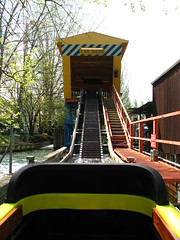 The gigantic 300 foot tall Euro-Wheel was closed when I made my way to the very rear of the park (which, despite some very well-landscaped pathways, was otherwise a bit barren on actual activities to do) but I couldn’t tell if it was rotating or not later in the day. With this out of the picture, I spent my time on two of their water rides, starting with the Autosplash. Although the question of why a log flume would be given automobile themed boats is still a mystery to most, the ride was a pleasant if not conventional flume with some odd bits of retro 80’s to early-90’s themeing thrown in. Something about it, from the scaffolding supports and wooden planked conveyors, to the bright candy colors and ‘car wash’ tunnel, gave it an unusual and fun character. It also offered some unique views of the back of iSpeed which was a plus.
The gigantic 300 foot tall Euro-Wheel was closed when I made my way to the very rear of the park (which, despite some very well-landscaped pathways, was otherwise a bit barren on actual activities to do) but I couldn’t tell if it was rotating or not later in the day. With this out of the picture, I spent my time on two of their water rides, starting with the Autosplash. Although the question of why a log flume would be given automobile themed boats is still a mystery to most, the ride was a pleasant if not conventional flume with some odd bits of retro 80’s to early-90’s themeing thrown in. Something about it, from the scaffolding supports and wooden planked conveyors, to the bright candy colors and ‘car wash’ tunnel, gave it an unusual and fun character. It also offered some unique views of the back of iSpeed which was a plus.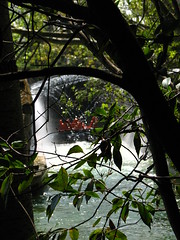
While their Niagara shoot-the-chutes and Raratonga splash battle were too wet for my tastes, after scouting out the visible parts of the Rio Bravo rafting ride and noting it didn’t appear to be particularly sloshy I decided to join the queue. The river was a basic concrete channel through a densely forested setting with a few rapids and waves thrown in. There was little in the way of themed sets or objects, and mercifully no geysers or waterfalls built over the raft’s path. Just when it seemed this would be another European ‘dry’ water ride, with more emphasis on scenic tranquility than soaking its riders, we floated around a final bend, and laid out ahead was a long straight channel through a large aqueduct. Numerous jets of water arched overhead creating a ‘tunnel’ effect, but whether by design or by accident a number of these jets had low enough water pressure that rather arch over the boat, they arched down and into the boat. Uh oh. A last second scramble to zip my coat and flip my hood while securing my camera case inside meant my ears were saved a cleaning by a layer of synthetic fabric, although my pants still got soaked through, not the most pleasant situation for an April spring day. I doubt there would have been much to make the Rio Bravo stick in my memory if it hadn’t been for this finale, so it may have been for the best anyway.
I doubt there would have been much to make the Rio Bravo stick in my memory if it hadn’t been for this finale, so it may have been for the best anyway.
Exiting through a service gate in the established park boundaries and walking along a former maintenance road for a good five minutes will eventually dead-end into the post-apocalyptic entry plaza for Reset: Anno Zero, one of Mirabilandia’s newest and most expensive attractions (as evidenced by the painstaking effort put into integrating it with the rest of the infrastructure). I’ll give it credit for being an original concept… at least in the world of dark rides. Eschatological cinema has been around for a long time, fueled by our collective horror over past international traumas (I wonder aloud, is there any specific reason Reset takes place in NYC rather than, say, Rome or Milan?) and the genre’s subconscious prodding of a latent guilt western society seems to share; that is, we secretly do not expect our current decadent lifestyles to last to the end of our lifespan, at least not if the Chinese and other impoverished, developing nations on whose shoulders we stand have anything to say about it over the next decade. There’s also a hidden desire in these 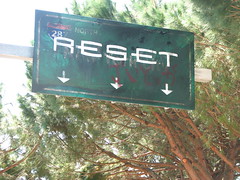 stories to escape from the establishment and ‘reset’ our mundane lives, finding new existential purpose in utilizing one’s survival skills to afford a living rather than our current alienated reliance on the system to provide our every need. It’s a chance to turn the tables on the master-slave dialectic, because every zombie outbreak movie depicts some form of reverse gentrification, in which the hard-working underprivileged and/or the public outcasts that have actually read the Zombie Survival Guide in their mom’s basement become the new saviors upon whom their former social superiors must now depend for survival or be thrown to the dogs.
stories to escape from the establishment and ‘reset’ our mundane lives, finding new existential purpose in utilizing one’s survival skills to afford a living rather than our current alienated reliance on the system to provide our every need. It’s a chance to turn the tables on the master-slave dialectic, because every zombie outbreak movie depicts some form of reverse gentrification, in which the hard-working underprivileged and/or the public outcasts that have actually read the Zombie Survival Guide in their mom’s basement become the new saviors upon whom their former social superiors must now depend for survival or be thrown to the dogs.
This is why Reset was a bit of a disappointment for me. The theme promised to be within easy grasp of much bigger concepts that its creative designers were ultimately unwilling to reach for. I’ve spoken against using narratives in dark rides before, noting that those that use atmospheric settings seem to be far more successful. This shouldn’t be misconstrued as a fundamental favoring of one form or another, only a comment that currently dark ride designers seem to be better skilled at set design than story-telling, and until someone comes along with the ability to change that, for the sake of pragmatism only, they should stick to the atmosphere. This was not a good solution for Reset, however, which needed more ideas and fewer gloomy sets of war-torn city streets which only begged the question, “why?” Does it want me to recoil in terror at the pure destructive force on display? Am I to feel incredible sadness at the end of the world and loss of human life?
bigger concepts that its creative designers were ultimately unwilling to reach for. I’ve spoken against using narratives in dark rides before, noting that those that use atmospheric settings seem to be far more successful. This shouldn’t be misconstrued as a fundamental favoring of one form or another, only a comment that currently dark ride designers seem to be better skilled at set design than story-telling, and until someone comes along with the ability to change that, for the sake of pragmatism only, they should stick to the atmosphere. This was not a good solution for Reset, however, which needed more ideas and fewer gloomy sets of war-torn city streets which only begged the question, “why?” Does it want me to recoil in terror at the pure destructive force on display? Am I to feel incredible sadness at the end of the world and loss of human life?  Or, as the name suggests, is this an adventure, a chance to witness the spectacle of mass carnage as a signal for a fresh start? We don’t know because there’s a refusal to allow for any sort of emotional connection with all the sterile, still life scenery. News report broadcasts over television (all in Italian) may have filled in some of the void I was unable to comprehend, but someone could reply with a translation and that would hardly change matters,
Or, as the name suggests, is this an adventure, a chance to witness the spectacle of mass carnage as a signal for a fresh start? We don’t know because there’s a refusal to allow for any sort of emotional connection with all the sterile, still life scenery. News report broadcasts over television (all in Italian) may have filled in some of the void I was unable to comprehend, but someone could reply with a translation and that would hardly change matters,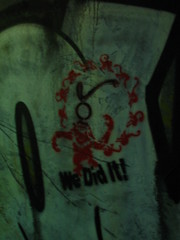 since the last time I experienced a story which stated all of its key ideas through talking heads telling you how to interpret the events, I didn’t think very highly of it anyway. Instead Reset struck me as a half-baked attempt to channel the creative energy coursing through films such as Terry Gilliam’s Twelve Monkeys (did anyone else notice the Army of the 12 Monkeys symbol spray-painted on a wall near the exit?) without understanding what really makes them tick, and then using it as a mere backdrop for another silly interactive shooter darkride, where the only genuine emotional response one can expect to have is “my laser gun isn’t working!”
since the last time I experienced a story which stated all of its key ideas through talking heads telling you how to interpret the events, I didn’t think very highly of it anyway. Instead Reset struck me as a half-baked attempt to channel the creative energy coursing through films such as Terry Gilliam’s Twelve Monkeys (did anyone else notice the Army of the 12 Monkeys symbol spray-painted on a wall near the exit?) without understanding what really makes them tick, and then using it as a mere backdrop for another silly interactive shooter darkride, where the only genuine emotional response one can expect to have is “my laser gun isn’t working!”
But hey, at least it was an attempt, worthy a critical analysis of more than two lines dismissing it as another Haunted Mansion knockoff. In the amusement industry that alone can be sufficient for a sparklingly positive review.
Comments